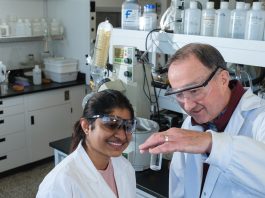Quantum Generative Materials, LLC (GenMat™) is a materials science company working to expand the boundaries of human capabilities through the application of fundamentally new understandings of material properties at the quantum level.
GenMat stands at the forefront of an emerging materials science revolution, pioneering solutions with immediate transformative applications in energy, electronics, and space-based sensing. Our approach synergises artificial intelligence (AI), classical machine learning, quantum simulation, and high-fidelity quantum chemical data sets to accelerate breakthroughs in materials science.
Throughout history, the discovery of new materials has been the cornerstone of technological progress, defining entire epochs: Stone Age, Bronze Age, Iron Age, and Silicon Age. Where past discoveries were often serendipitous, GenMat plans to shift the paradigm to the intentional design of revolutionary materials.
GenMat’s inception came from the realisation that by harnessing cutting-edge machine learning and early quantum computing capabilities, there was an opportunity to engineer materials that would fundamentally disrupt global markets.
Our innovations yield tangible results of actionable inference from optimised catalyst designs, advanced hyperspectral sensing technologies, predictive modelling, and the creation of novel materials from ideal structures. These advancements herald a new era of transformational breakthroughs in critical sectors such as energy storage, photovoltaics, superconductivity, and beyond.
Quantum-enabled materials simulation
GenMat tackles the immense complexity of quantum-level material property computation head-on. In traditional approaches, computing the state of electron entanglement alone is a 2N problem before factors such as spin, kinetic energy, and potential energy are calculated. Direct simulation of quantum properties becomes infeasible on the most powerful classical computational platforms, even with small atomic systems. GenMat identified this problem and has worked tirelessly to overcome it.
Our proprietary approach fuses classical computational chemistry, including density functional theory (DFT) and post-DFT methods, with advanced machine learning and quantum computing. This synergy maximises the value gained from each field, creating a robust network of algorithms and datasets that continuously evolve and improve. We offer our expertise in DFT, simulation, and machine learning as consulting services to clients to drive innovation across industries.
GenMat’s efforts can be reduced to three incremental phases of work and their associated products:
- Characterisation of existing materials to generate comprehensive datasets, deriving crucial insights from advanced sensors;
- Optimisation of these known materials to improve their performance; and
- Generation of novel material structures tailored to specific requirements. This methodology is already yielding results, such as our work on an optimised photocatalyst poised to significantly reduce humanity’s carbon footprint.
GenMat’s ability to characterise existing materials sets the foundation for meaningful applications of machine learning in materials science. Our pioneering integration of computational chemistry and machine learning methodologies enables a deep understanding of material properties, advanced simulation capabilities, and optimisation of device design and material behaviours.
While valuable on their own, our characterisation capabilities primarily serve as the basis for the generation of new material configurations. By initially focusing on optimising known materials, we confine the search space and transform an enormously complex problem into an achievable goal at the forefront of current technology. For example, GenMat is working to enhance the efficiency of a photocatalyst that converts CO2, water, and sunlight into usable hydrocarbon reserves, which represents a crucial step toward a carbon-neutral future.
Our iterative optimisation of existing material is also a learning process wherein GenMat’s team of scientists and engineers continuously refines models for specific material classes. The goal is the computational discovery of fundamentally new materials precisely tuned to client and industry needs. This capability will drive innovation in many sectors, such as semiconductors, energy storage, superconductors, and aerospace materials.
Material characterisation and remote sensing
The compute-to-synthesis pipeline and dataset for achieving GenMat’s roadmap is built on a foundation of precise material property understanding and cutting-edge experimental measurement methodologies. This advanced system ingests complex sensor data, employs sophisticated algorithms to infer material characteristics, and generates inferences about the characteristics of the materials imaged by the sensor. This computational tool, originally built to measure emissive properties via microscopic imaging tools, can be tuned to make directly actionable inferences about the material properties of images taken from a wide range of operational sensors, dramatically expanding their application scope.

Recognising the critical role of rare earth minerals in advanced material development, GenMat launched its first satellite, GENMAT-1, with the intent of making detailed inferences about material characteristics for dramatically increasing the efficiency of mineral discovery. GENMAT-1 is equipped with a hyperspectral imager capable of 5m-per-pixel resolution in the 450nm to 900nm spectral range. This creates the opportunity to conduct highly-focused experimentation, validation, and exploration in areas where mining rights are already secured for optimal product development and maturation.
Our innovative use of hyperspectral data, combined with advanced DFT and post-DFT methods, is opening new frontiers in material analysis. This technology has far-reaching implications beyond mining, including structural composition analysis, anti-spoofing applications, and ionisation detection. These capabilities position GenMat at the vanguard of space-based sensing technology, with potential applications across multiple sectors.
Material optimisation and generative capabilities
In the face of global climate challenges, GenMat understands the urgent need for sustainable energy without compromising economic stability. Recognising that the world’s reliance on fossil fuels cannot be immediately eliminated, despite rapid advancements in green energy, we have focused our efforts on mitigating the environmental impact of hydrocarbon extraction and usage.
Our flagship project in this arena is the development and optimisation of an advanced photocatalyst that transforms CO2, water, and sunlight into usable hydrocarbons, effectively closing the carbon cycle. Our photocatalysts demonstrate an efficiency in CO2 conversion that is 3.8 times greater than that of an average forest. To put this into perspective, a single square kilometre of our material can generate 15 million cubic metres of usable natural gas annually. This remarkable capability not only represents a significant leap in environmental technology but also holds substantial implications for the global hydrocarbon industry. Driven by these promising results, GenMat is committed to further enhancing the photoconversion efficiency of this groundbreaking material.
The challenge of increasing photoconversion efficiency exemplifies the complex interplay between artificial intelligence and materials science that defines GenMat’s methodology. While it represents a well-defined optimisation problem, it also showcases the immense potential of AI in pushing the boundaries of material discovery. Our progress to date in characterising and predicting existing material properties provides a compelling basis for the work. The creation and scaling of such a photocatalyst could reduce global reliance on new drilling. When coupled with established gas-to-liquid processes, this innovation could provide a sustainable source for systems currently dependent on jet fuel, gasoline, and other petroleum products.
Moving forward
GenMat is laying the foundation for the company’s unique Artificial General Physics Intelligence (AGPI™) – building and applying physics-based AI to materials discovery and remote sensing. With this outlook, advanced photocatalysts can initially be classified as both materials and devices. However, it is not only about discovering new materials; it is also about developing a body of knowledge for practical application of what can be learned, ultimately making technology indistinguishable from nature.
© 2024 GenMat. GenMat and AGPI are trademarks of Quantum Generative Materials, LLC. All rights reserved.
Please note, this article will also appear in the 19th edition of our quarterly publication.









